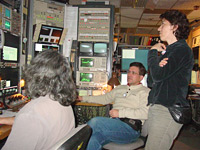 |
 |
|||||||||||||
|
|||||||||||||
|
|||||||||||||
|
In the end of January, the Laboratory for Elementary Particle Physics (LEPP) at Cornell University hosted collaborators from KEK, Lawrence Livermore National Laboratory, Argonne National Laboratory and Alfred University (an undergraduate University in New York State) to conduct electron cloud studies using the CESR storage ring. CESR is unique in that it is a “wiggler dominated” storage ring capable of storing intense beams of both electrons and positrons, singly or simultaneously. An electron cloud is a potential concern for ILC damping rings as its presence can dilute the emittance, or density, of the beam, leading to instability which limits the useful current and therefore luminosity of the ILC. Using trains of beam bunches with variable spacing, CESR instrumentation permitted the team to measure beam size growth, signaling the presence of a strong electron cloud and giving important data on the nature of the growth. Subsequently, the team also measured the “tune” of each bunch in the train to see the growing influence of the electron cloud as the train passes. Curiously, while one expects that the effect of the electron cloud will be most severe for positron beams, significant effects were also noted for electron beams. Such measurements, as well as direct measurements of electron and ion densities, will help the GDE design mitigation methods to assure that the ILC damping rings will be electron-cloud-free and able to achieve the intensity and unprecedented brightness required for design luminosity. While at LEPP, the participants from KEK, LLNL and ANL gave seminars on observations of electron cloud effects in accelerators at their institutions. ILC researchers learned from a LLNL collaborator that the electron cloud is very important for heavy ion fusion machines, too. Sharing information and ideas across such diversity is bound to strengthen understanding of the underlying science involved and enhance experimental techniques for investigating it. As an indication of interest in studying electron cloud effects, more than fifteen groups of accelerator experts in the three regions have expressed interest in joining such studies at CESR. Several scientists have written letters of commitment to participate in the programme, in the event that CESR will be supported for electron cloud studies. -- Maury Tigner, Cornell University |
|||||||||||||
| © International Linear Collider |
